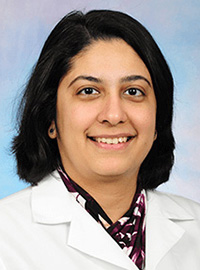May 29, 2020:
The American Society of Clinical Oncology’s ASCO20 Virtual Scientific Program will feature abstracts from four Big Ten Cancer Research Consortium studies. The program, taking place May 29-31, will feature more than 250 oral abstract presentations and 2,500 poster presentations from 24 disease-based and specialty tracks.
The abstracts featuring Big Ten CRC studies include poster discussions for BTCRC-GYN15-013 and BTCRC-LUN16-081 and posters for BTCRC-AML17-113 and BTCRC-ESO14-012.
BTCRC-LUN16-081
 The BTCRC-LUN16-081 poster discussion, titled “Consolidation nivolumab/ipilimumab versus nivolumab following concurrent chemoradiation in patients with unresectable stage III NSCLC: A planned interim safety analysis from the BTCRC-LUN16-081 trial,” reported toxicity data from the first 50 subjects enrolled on the study.
The BTCRC-LUN16-081 poster discussion, titled “Consolidation nivolumab/ipilimumab versus nivolumab following concurrent chemoradiation in patients with unresectable stage III NSCLC: A planned interim safety analysis from the BTCRC-LUN16-081 trial,” reported toxicity data from the first 50 subjects enrolled on the study.
The randomized multi-center phase II study, led by Greg Durm, MD, of the Indiana University Melvin and Bren Simon Comprehensive Cancer Center, is currently open to accrual at academic cancer centers across the Midwest, with a target enrollment of 105 subjects with stage IIIA/IIIB non-small cell lung cancer (NSCLC).
Through this study, investigators want to determine whether two immunotherapy drugs are better than one, said Dr. Durm. The interim safety analysis provides toxicity data for both arms of the study. Investigators are also are looking at immune-related side effects and how frequently patients have to stop treatment.
“On the nivolumab-alone arm, 76% of patients were able to complete the 24 weeks of treatment,” Dr. Durm said. “When you use the two drugs, nivolumab plus ipilimumab, we noticed that drops off to only 56%.”
Investigators also discovered there was a greater incidence of immune-related side effects in the nivolumab plus ipilimumab arm. “It goes up from 44% in the single-drug arm to 60% in the arm with both drugs,” Dr. Durm said. “And when you look at the higher-grade toxicities, it goes up from 16 to 32%.”
Researchers were expecting to see this increase in immune-related side effects, said Dr. Durm, but they wanted to make sure the two drugs were manageable and not overly toxic. “What we found was despite the fact there is more toxicity, there were zero patients on either arm who died related to treatment. Almost all the patients who got immune-related adverse events have done well and recovered with supportive care treatments,” he said.
Dr. Durm credits Indiana University School of Medicine fellow Melissa Yan, MD, for leading the interim analysis.
BTCRC-GYN15-013
 The BTCRC-GYN15-013 poster discussion, titled “A Big Ten Cancer Research Consortium phase II trial of pembrolizumab with carboplatin and paclitaxel for advanced or recurrent endometrial cancer,” presents results from the single-arm multi-institution study, BTCRC-GYN15-013, led by Daniela Matei, MD, of the Robert H. Lurie Comprehensive Cancer Center of Northwestern University.
The BTCRC-GYN15-013 poster discussion, titled “A Big Ten Cancer Research Consortium phase II trial of pembrolizumab with carboplatin and paclitaxel for advanced or recurrent endometrial cancer,” presents results from the single-arm multi-institution study, BTCRC-GYN15-013, led by Daniela Matei, MD, of the Robert H. Lurie Comprehensive Cancer Center of Northwestern University.
The goal of the study was to assess the efficacy and safety of pembrolizumab in combination with standard carboplatin/paclitaxel in patients with measurable advanced or recurrent endometrial cancer. The study enrolled 46 subjects.
Researchers concluded: The addition of pembrolizumab to standard chemotherapy for advanced or recurrent endometrial cancer induced a clinically significant improvement in objective response rate compared to historical outcomes, and toxicity did not exceed levels of the standard treatment, supporting further testing in a phase III trial.
BTCRC-ESO14-012
 The BTCRC-ESO14-012 poster, titled “Durvalumab following multimodality therapy for locally advanced esophageal adenocarcinoma and GE junction adenocarcinoma: Updated survival and early translational results from Big Ten Cancer Research Consortium Study,” reported data from the BTCRC-ESO14-012 study, led by Shadia Jalal, MD, of the Indiana University Melvin and Bren Simon Comprehensive Cancer Center, and co-investigator Hirva Mamdani, MD (pictured), of the Barbara Ann Karmanos Cancer Institute in Detroit, Mich. The primary endpoint of the study is 1-year relapse free survival (RFS) and secondary endpoints are safety and feasibility. The study enrolled a total of 37 patients, including an initial cohort of 24 patients.
The BTCRC-ESO14-012 poster, titled “Durvalumab following multimodality therapy for locally advanced esophageal adenocarcinoma and GE junction adenocarcinoma: Updated survival and early translational results from Big Ten Cancer Research Consortium Study,” reported data from the BTCRC-ESO14-012 study, led by Shadia Jalal, MD, of the Indiana University Melvin and Bren Simon Comprehensive Cancer Center, and co-investigator Hirva Mamdani, MD (pictured), of the Barbara Ann Karmanos Cancer Institute in Detroit, Mich. The primary endpoint of the study is 1-year relapse free survival (RFS) and secondary endpoints are safety and feasibility. The study enrolled a total of 37 patients, including an initial cohort of 24 patients.
Investigators reported the study met its primary endpoint with the initial cohort, with 1-year RFS of 79% compared to a historical control rate of 50%. About 55% of patients remained alive and disease-free at 2 years. Overall survival at 1- and 2-years was 95% and 68% respectively. Durvalumab was generally well tolerated with no new safety concerns noted. Several correlative studies are currently underway, including assessment of PD-L1 expression, tumor mutational burden, Immunoscore, genomic profiling, and circulating tumor cells.
Researchers also concluded: HER-2 positivity could be associated with lack of benefit from durvalumab, mutations in DNA repair genes are prevalent in subjects with delayed relapse, and a rise in circulating tumor cells during durvalumab therapy may be an early marker of disease relapse.
BTCRC-AML17-113
 The BTCRC-AML17-113 poster provides safety and efficacy data for the Phase Ib study of gemtuzumab ozogamicin (GO) and venetoclax in patients with relapsed or refractory CD33+ acute myeloid leukemia. The BTCRC-AML17-113 study is led by John Quigley, MD, of the University of Illinois Cancer Center and is currently enrolling subjects at three Big Ten CRC member institutions.
The BTCRC-AML17-113 poster provides safety and efficacy data for the Phase Ib study of gemtuzumab ozogamicin (GO) and venetoclax in patients with relapsed or refractory CD33+ acute myeloid leukemia. The BTCRC-AML17-113 study is led by John Quigley, MD, of the University of Illinois Cancer Center and is currently enrolling subjects at three Big Ten CRC member institutions.
The goal of this study is to determine the maximum tolerated dose of venetoclax in combination with GO for this patient population. Researchers hypothesize venetoclax targeting of Bcl-2 proteins that protect AML stem cells from GO-induced apoptosis will synergistically increase GO efficacy.
“We are delighted ASCO reviewers have recognized the importance of this study by accepting it for publication at this year’s virtual meeting,” Dr. Quigley said. “No major or unexpected toxicities were observed in Cohort 1.”
About the Big Ten Cancer Research Consortium: The Big Ten Cancer Research Consortium was created in 2013 to transform the conduct of cancer research through collaborative, hypothesis-driven, highly translational oncology trials that leverage the scientific and clinical expertise of Big Ten universities. The goal of the Big Ten Cancer Research Consortium is to create a unique team-research culture to drive science rapidly from ideas to new approaches to cancer treatment. Within this innovative environment, today’s research leaders collaborate with and mentor the research leaders of tomorrow with the unified goal of improving the lives of all patients with cancer.
About the Big Ten Conference: The Big Ten Conference is an association of world-class universities whose member institutions share a common mission of research, graduate, professional and undergraduate teaching and public service. Founded in 1896, the Big Ten has sustained a comprehensive set of shared practices and policies that enforce the priority of academics in the lives of students competing in intercollegiate athletics and emphasize the values of integrity, fairness and competitiveness. The broad-based programs of the 14 Big Ten institutions will provide over $200 million in direct financial support to more than 9,800 students for more than 11,000 participation opportunities on 350 teams in 42 different sports. The Big Ten sponsors 28 official conference sports, 14 for men and 14 for women, including the addition of men’s ice hockey and men’s and women’s lacrosse since 2013. For more information, visit www.bigten.org.
















Subscribe to the Big Ten CRC Newsletter X
X Facebook
Facebook YouTube
YouTube